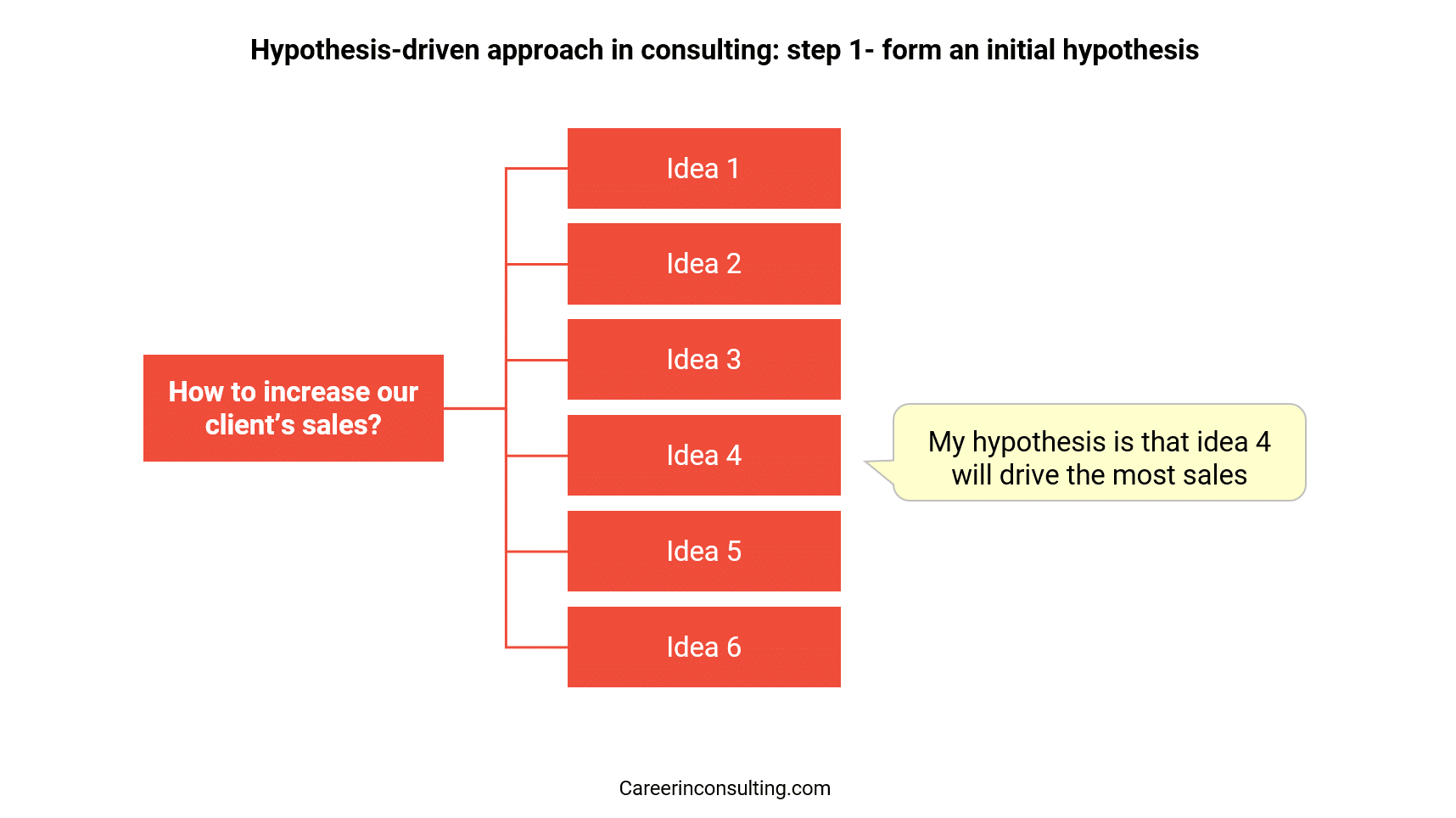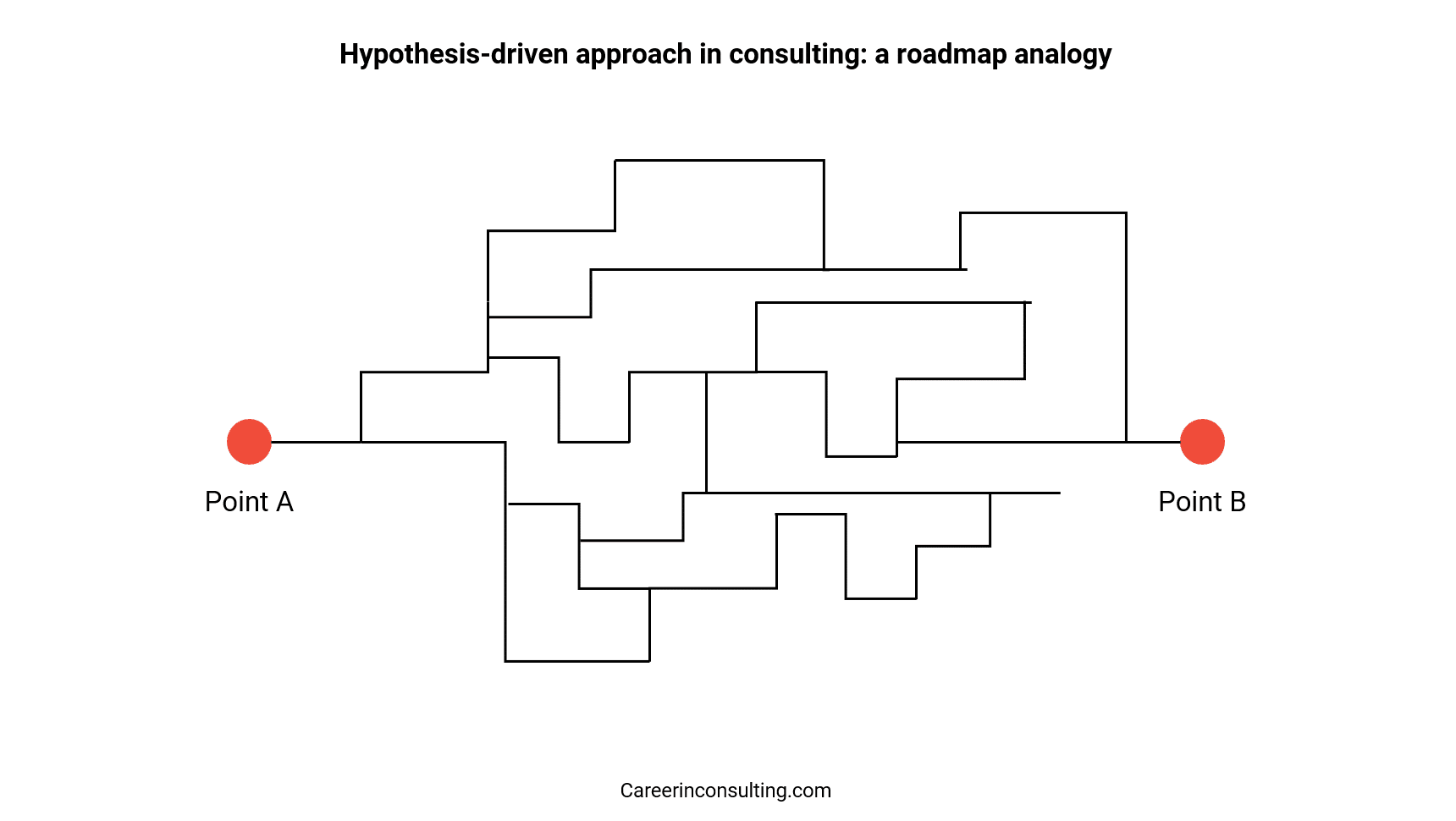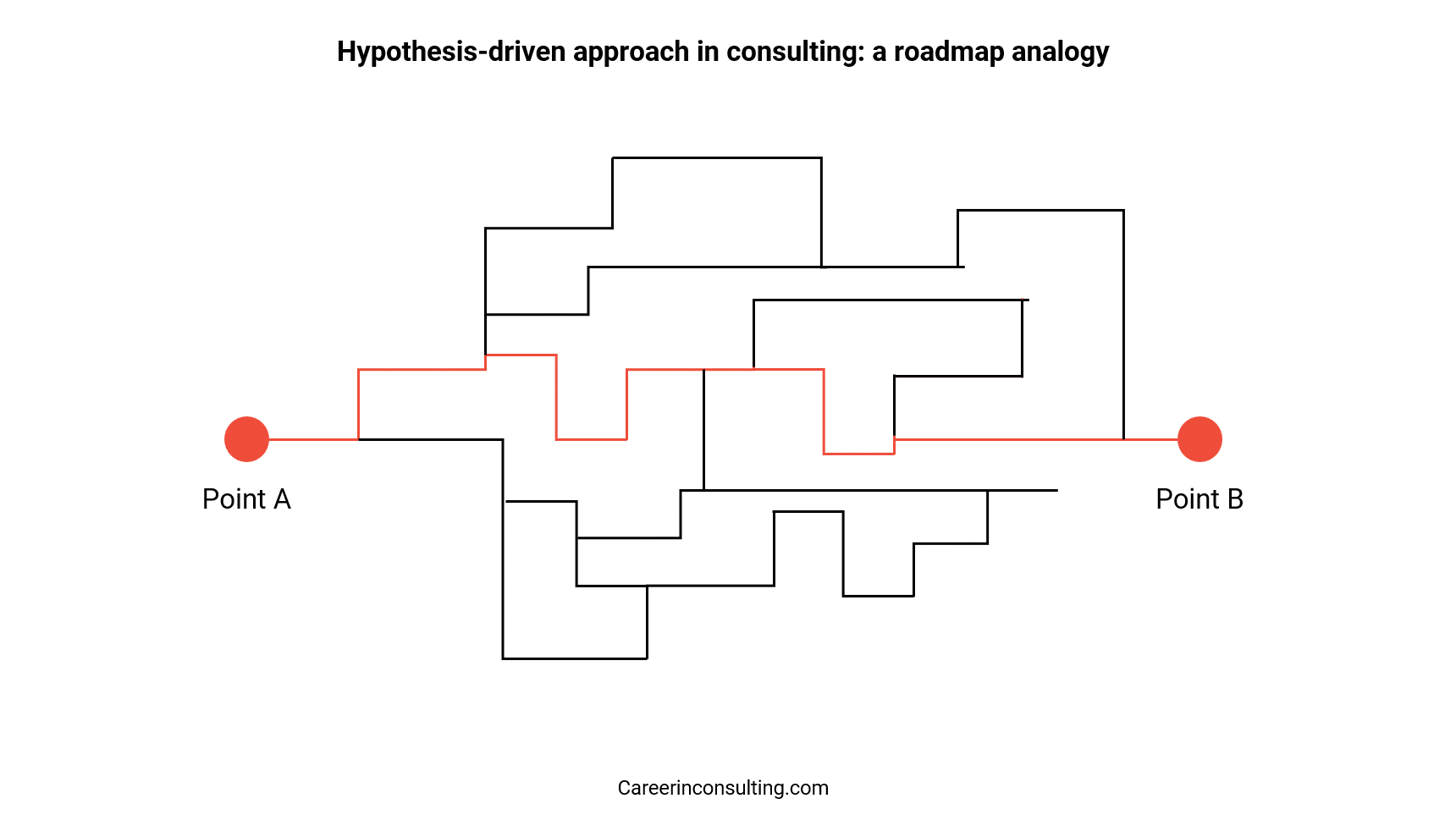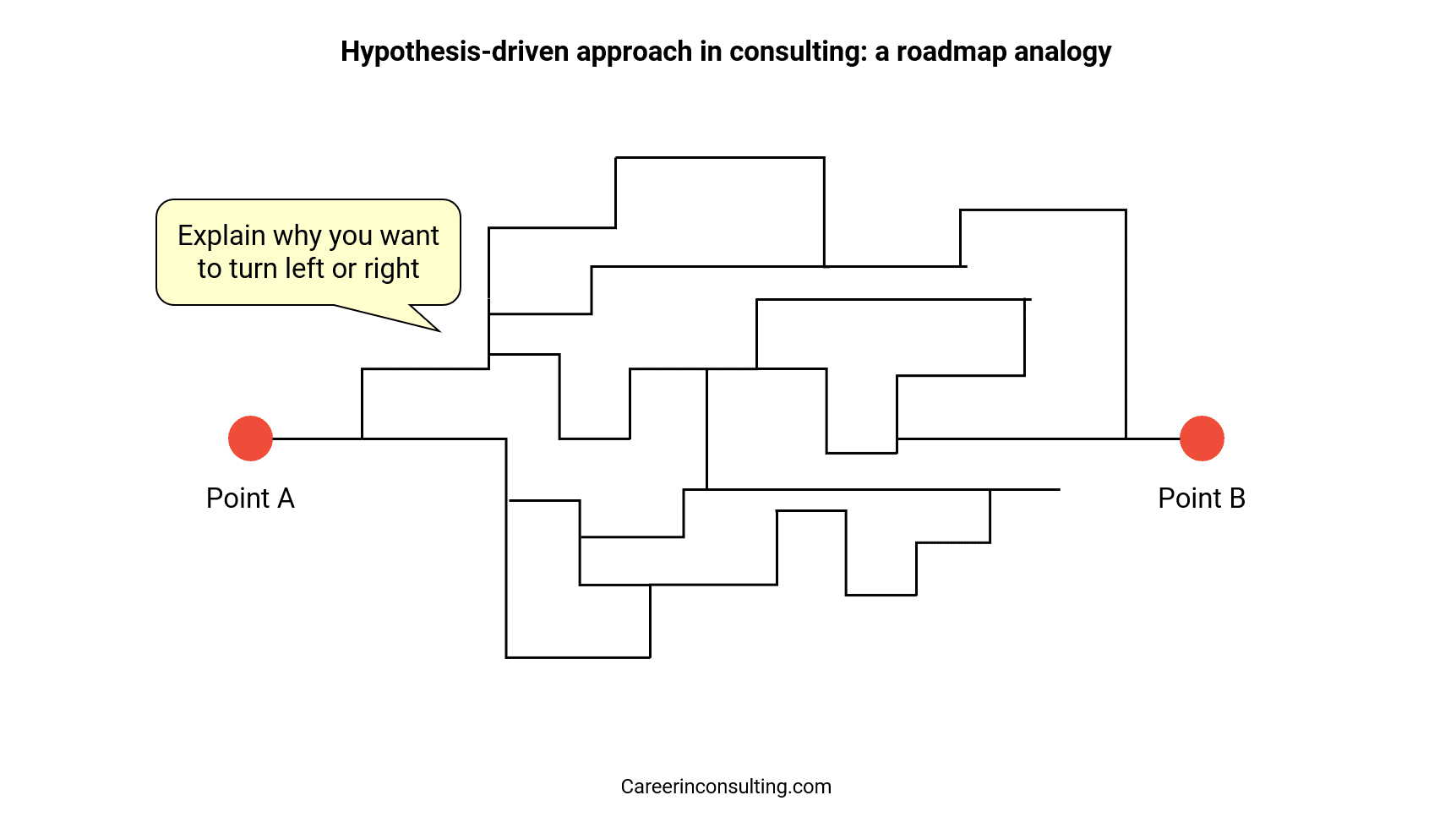Imagine you are walking in one of McKinsey’s offices.
Around you, there are a dozen of busy consultants.
The word “hypothesis” would be one of the words you would hear the most.
Along with “MECE” or “what’s the so-what?”.
This would also be true in any BCG, Bain & Company office or other major consulting firms.
Because strategy consultants are trained to use a hypothesis-driven approach to solve problems.
And as a candidate, you must demonstrate your capacity to be hypothesis-driven in your case interviews.
There is no turnaround:
If you want a consulting offer, you MUST know how to use a hypothesis-driven approach.
Like a consultant would be hypothesis-driven on a real project for a real client?
Hell, no! Big mistake!
Because like any (somehow) complex topics in life, the context matters.
What is correct in one context becomes incorrect if the context changes.
And this is exactly what’s happening with using a hypothesis-driven approach in case interviews.
This should be different from the hypothesis-driven approach used by consultant solving a problem for a real client.
And that’s why many candidates get it wrong (and fail their interviews).
They use a hypothesis-driven approach like they were already a consultant.
Thus, in this article, you’ll learn the correct definition of being hypothesis-driven in the context of case interviews.
Plus, you’ll learn how to use a hypothesis in your case interviews to “crack the case”, and more importantly get the well-deserved offer!
Ready? Let’s go. It will be super interesting!
Table of Contents
The wrong hypothesis-driven approach in case interviews
Let’s start with a definition:
Hypothesis-driven thinking is a problem-solving method whereby you start with the answer and work back to prove or disprove that answer through fact-finding.
Concretely, here is how consultants use a hypothesis-driven approach to solve their clients’ problems:
- Form an initial hypothesis, which is what they think the answer to the problem is.
- Craft a logic issue tree, by asking themselves “what needs to be true for the hypothesis to be true?”
- Walk their way down the issue tree and gather the necessary data to validate (or refute) the hypothesis.
- Reiterate the process from step 1 – if their first hypothesis was disproved by their analysis – until they get it right.

With this answer-first approach, consultants do not gather data to fish for an answer. They seek to test their hypotheses, which is a very efficient problem-solving process.
However:
The answer-first thinking works well if the initial hypothesis has been carefully formed.
This is why – in top consulting firms like McKinsey, BCG, or Bain & Company – the hypothesis is formed by a Partner with 20+ years of work experience.
And this is why this is NOT the right approach for case interviews.
Imagine a candidate doing a case interview at McKinsey and using answer-first thinking.
At the beginning of a case, this candidate forms a hypothesis (a potential answer to the problem), builds a logic tree, and gathers data to prove the hypothesis.
Here, there are two options:
The initial hypothesis is right
The initial hypothesis is wrong
If the hypothesis is right, what does it mean for the candidate?
That the candidate was lucky.
Nothing else.
And it certainly does not prove the problem-solving skills of this candidate (which is what is tested in case interviews).
Now, if the hypothesis is wrong, what’s happening next?
The candidate reiterates the process.
Imagine how disorganized the discussion with the interviewer can be.
Most of the time, such candidates cannot form another hypothesis, the case stops, and the candidate feels miserable.
This leads us to the right hypothesis-driven approach for case interviews.
The right hypothesis-driven approach in case interviews
To make my point clear between the wrong and right approach, I’ll take a non-business example.
Let’s imagine you want to move from point A to point B.
And for that, you have the choice among a multitude of roads.

Using the answer-first approach presented in the last section, you’d know which road to take to move from A to B (for instance the red line in the drawing below).

Again, this would not demonstrate your capacity to find the “best” road to go from A to B.
(regardless of what “best” means. It can be the fastest or the safest for instance.)
Now, a correct hypothesis-driven approach consists in drawing a map with all the potential routes between A and B, and explaining at each intersection why you want to turn left or right (”my hypothesis is that we should turn right”).

And in the context of case interviews?
In the above analogy:
- A is the problem
- B is the solution
- All the potential routes are the issues in your issue tree
And the explanation of why you want to take a certain road instead of another would be your hypothesis.
Is the difference between the wrong and right hypothesis-driven approach clearer?
If not, don’t worry. You’ll find many more examples below in this article.
But, next, let’s address another important question.
Why you must (always) use a hypothesis in your case interviews
You must use a hypothesis in your case interviews for two reasons.
A hypothesis helps you focus on what’s important to solve the case
Using a hypothesis-driven approach is critical to solving a problem efficiently.
In other words:
A hypothesis will limit the number of analysis you need to perform to solve a problem.
Thus, this is a way to apply the 80/20 principle and prioritize the issues (from your MECE issue tree) you want to investigate.
And this is very important because your time with your interviewer is limited (like is the time with your client on a real project).
Let’s take a simple example of a hypothesis:
The profits of your client have dropped.
And your initial analysis shows increasing costs and stagnating revenues.
So your hypothesis can be:
“I think something happened in our cost structure, causing the profit drop. Next, I’d like to understand better the cost structure of our clients and which cost items have changed recently.”
Here the candidate is rigorously “cutting” half of his/her issue tree (the revenue side) and will focus the case discussion on the cost side.
And this is a good example of a hypothesis in case interviews.
Get 4 Complete Case Interview Courses For Free

You need 4 skills to be successful in all case interviews: Case Structuring, Case Leadership, Case Analytics, and Communication. Join this free training and learn how to ace ANY case questions.
A hypothesis tells your interviewers why you want to do an analysis
There is a road that you NEVER want to take.
On this road, the purpose of the questions asked by a candidate is not clear.
Here are a few examples:
“What’s the market size? growth?”
“Who are the main competitors? what are their market shares?”
“Have customer preferences changed in this market?”
This list of questions might be relevant to solve the problem at stake.
But how these questions help solve the problem is not addressed.
Or in other words, the logical connection between these questions and the problem needs to be included.
So, a better example would be:
“We discovered that our client’s sales have declined for the past three years. I would like to know if this is specific to our client or if the whole market has the same trend. Can you tell me how the market size has changed over the past three years? »
In the above question, the reason why the candidate wants to investigate the market is clear: to narrow down the analysis to an internal root cause or an external root cause.
Yet, I see only a few (great) candidates asking clear and purposeful questions.
You want to be one of these candidates.
How to use a hypothesis-driven approach in your case interviews?
At this stage, you understand the importance of a hypothesis-driven approach in case interviews:
You want to identify the most promising areas to analyze (remember that time is money).
And there are two (and only two) ways to create a good hypothesis in your case interviews:
- a quantitative way
- a qualitative way
Let’s start with the quantitative way to develop a good hypothesis in your case interviews.
The quantitative approach: use the available data
Let’s use an example to understand this data-driven approach:
Interviewer: your client is manufacturing computers. They have been experiencing increasing costs and want to know how to address this issue.
Candidate: to begin with, I want to know the breakdown of their cost structure. Do you have information about the % breakdown of their costs?
Interviewer: their materials costs count for 30% and their manufacturing costs for 60%. The last 10% are SG&A costs.
Candidate: Given the importance of manufacturing costs, I’d like to analyze this part first. Do we know if manufacturing costs go up?
Interviewer: yes, manufacturing costs have increased by 20% over the past 2 years.
Candidate: interesting. Now, it would be interesting to understand why such an increase happened.
You can notice in this example how the candidate uses data to drive the case discussion and prioritize which analysis to perform.
The candidate made a (correct) hypothesis that the increasing costs were driven by the manufacturing costs (the biggest chunk of the cost structure).
Even if the hypothesis were incorrect, the candidate would have moved closer to the solution by eliminating an issue (manufacturing costs are not causing the overall cost increase).
That said, there is another way to develop a good hypothesis in your case interviews.
The qualitative approach: use your business acumen
Sometimes you don’t have data (yet) to make a good hypothesis.
Thus, you must use your business judgment and develop a hypothesis.
Again, let’s take an example to illustrate this approach.
Interviewer: your client manufactures computers and has been losing market shares to their direct competitors. They hired us to find the root cause of this problem.
Candidate: I think of many reasons explaining the drop in market shares. First, our client manufactures and sells not-competitive products. Secondly, we might price our products too high. Third, we need to use the right distribution channels. For instance, we might sell in brick-and-mortars stores when consumers buy their computers in e-stores like Amazon. Finally, I think of our marketing expenses. There may be too low or not used strategically.
Candidate: I see these products as commodities where consumers use price as the main buying decision criteria. That’s why I’d like to explore how our client prices their products. Do you have information about how our prices compare to competitors’?
Interviewer: this is a valid point. Here is the data you want to analyze.
Note how this candidate explains what she/he wants to analyze first (prices) and why (computers are commodities).
In this case interview, the hypothesis-driven approach looks like this:
This is a commodity industry —> consumers buying behavior is driven by pricing —> our client’s prices are too high.
Again, note how the candidate first listed the potential root causes for this situation and did not use an answer-first approach.
Want to learn more?
In this free training, I explain in detail how to use data or your business acumen to prioritize the issues to analyze and “crack the case.”
Also, you’ll learn what to do if you don’t have data or can’t use your business acumen.
Form a hypothesis in these two critical moments of your case interviews
After you’ve presented your initial structure
The first moment to form a hypothesis in your case interview?
In the beginning, after you’ve presented your structure.
When you’ve presented your issue tree, mention which issue you want to analyze first.
Also, explain why you want to investigate this first issue.
In other words:
Make clear how the outcome of the analysis of this issue will help you solve the problem.
After an analysis
The second moment to form a hypothesis in your case interview?
After you’ve derived an insight from data analysis.
This insight has proved (or disproved) your hypothesis.
Either way, after you have developed an insight, you must form a new hypothesis.
This can be the issue you want to analyze next.
Or what a solution to the problem is.
Hypothesis-driven approach in case interviews: a conclusion
Having spent about 10 years coaching candidates through the consulting recruitment process, one commonality of successful candidates is that they truly understand how to be hypothesis-driven and demonstrate efficient problem-solving.
Plus, per my experience in coaching candidates, not being able to use a hypothesis is the second cause of rejection in case interviews (the first being the lack of MECEness).
This means you can’t afford NOT to master this concept in a case study.
So, sign up now for this free course to learn how to use a hypothesis-driven approach in your case interviews and land your dream consulting job.
More than 7,000 people have already signed up.
Don’t waste one more minute!
See you there.
Sébastien
Get 4 Complete Case Interview Courses For Free

You need 4 skills to be successful in all case interviews: Case Structuring, Case Leadership, Case Analytics, and Communication. Join this free training and learn how to ace ANY case questions.
SHARE THIS POST
